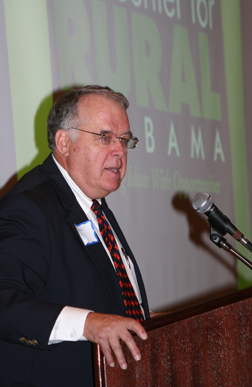A REASON TO PONDER: Rural School Study Points To 10 Schools That Beat The Odds

When Larry Lee is asked what the Center for Rural Alabama does, he replies: “We ponder.”
But it was Lee who gave more than 300 people reason to ponder May 6 when he unveiled the findings of the center’s year-long journey across the state to answer the question: Why, despite limited resources and overwhelming odds, do some rural schools succeed?It was a question that drew educators, community leaders, legislators and other elected officials to Prattville’s Marriot Legends for “Celebrating Rural Schools,” an event that not only recognized 10 leading rural schools in Alabama but also detailed why they are exceeding expectations.
The Alfa Foundation funded the study, which was a partnership of the Alabama Farmers Federation and Alfa Insurance, the Economic Development Association of Alabama and the Alabama Department of Agriculture & Industries.”Are these the 10 best schools in rural Alabama?” asked Lee, director of the center that is part of the Alabama Department of Agriculture & Industries. “We’re not willing to say that these are the 10 best schools, but I’ll tell you what we will say: ‘You go try to find 10 that are any better, and we’ll take our 10 and we’ll whip your 10.'”Geographically and demographically diverse, the schools are identified in the center’s eye-opening 40-page publication, Lessons Learned From Rural Schools, as outstanding examples of communities that work together, principals who motivate, teachers who inspire and students who excel despite often dire economic and social circumstances.The schools include Calcedeaver Elementary in Mobile County, which has 81.5 percent of its 249 mostly Native American students on free-reduced lunch programs but scored 81 percent on the 6th Grade Math exam, 62 percent better than the state average. There’s also Dutton School in Jackson County, a 244-student K-8 school with 68 percent of its students on free-reduced lunches. It scored 79 percent on the fourth-grade math exam; the state average is 38.Others include F.S. Ervin Elementary in Wilcox County, Fruithurst Elementary in Cleburne County, W.S. Harlan Elementary in Covington County, Huxford Elementary in Escambia County, Meek Elementary in Winston County, Phil Campbell Elementary in Franklin County, Southern Choctaw Elementary in Choctaw County and Albert Turner Elementary in Perry County.Lee, who conducted the study along with Gerald Carter of Gerald Carter & Associates and Dr. Owen Sweatt of the University of Alabama, examined more than 200 rural schools, traveled more than 10,000 miles and interviewed more than 300 teachers and principals to learn the secrets of the school’s success.Although Lessons Learned From Rural Schools is plentiful with supporting data, Lee writes in his report that he and his colleagues didn’t find “any deep dark secrets, silver bullets or magic potions. Instead, we found a lot of common sense, mixed with a lot of passion, love and caring.””I hope this catches on and becomes an epidemic across this state,” said Agriculture Commissioner Ron Sparks. “I think this is an example that, if communities and education come together and put on that thinking cap, our children can achieve anything.”For more information or to request copies of Lessons Learned From Rural Schools, visit www.AlfaFarmers.org/headlines/headline.phtml?id=5538, contact Larry Lee at (334) 240-7272 or email larry.lee@agi.alabama.gov.
